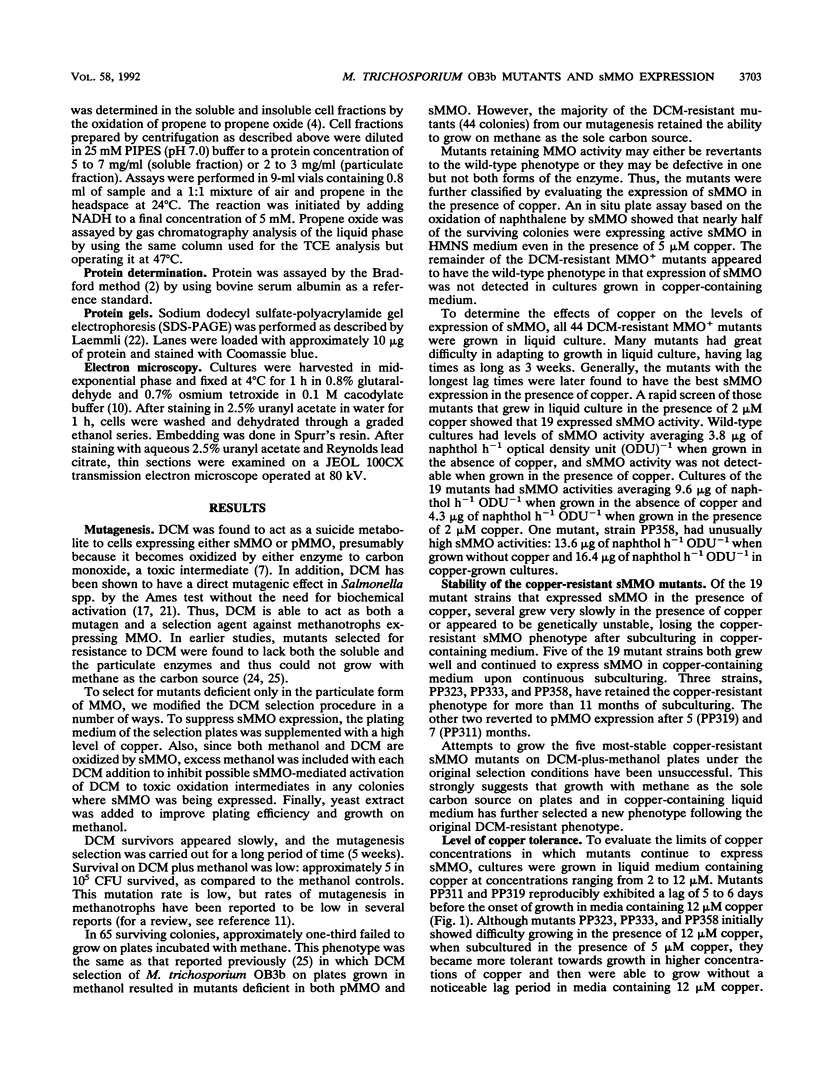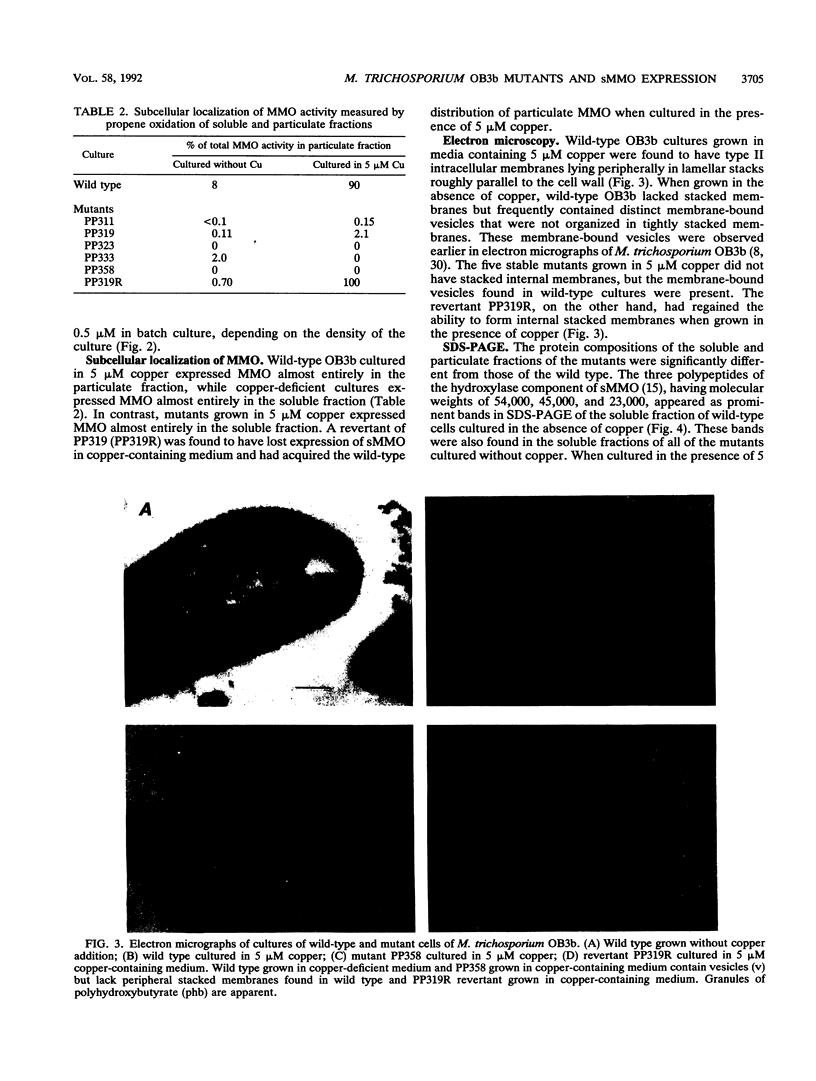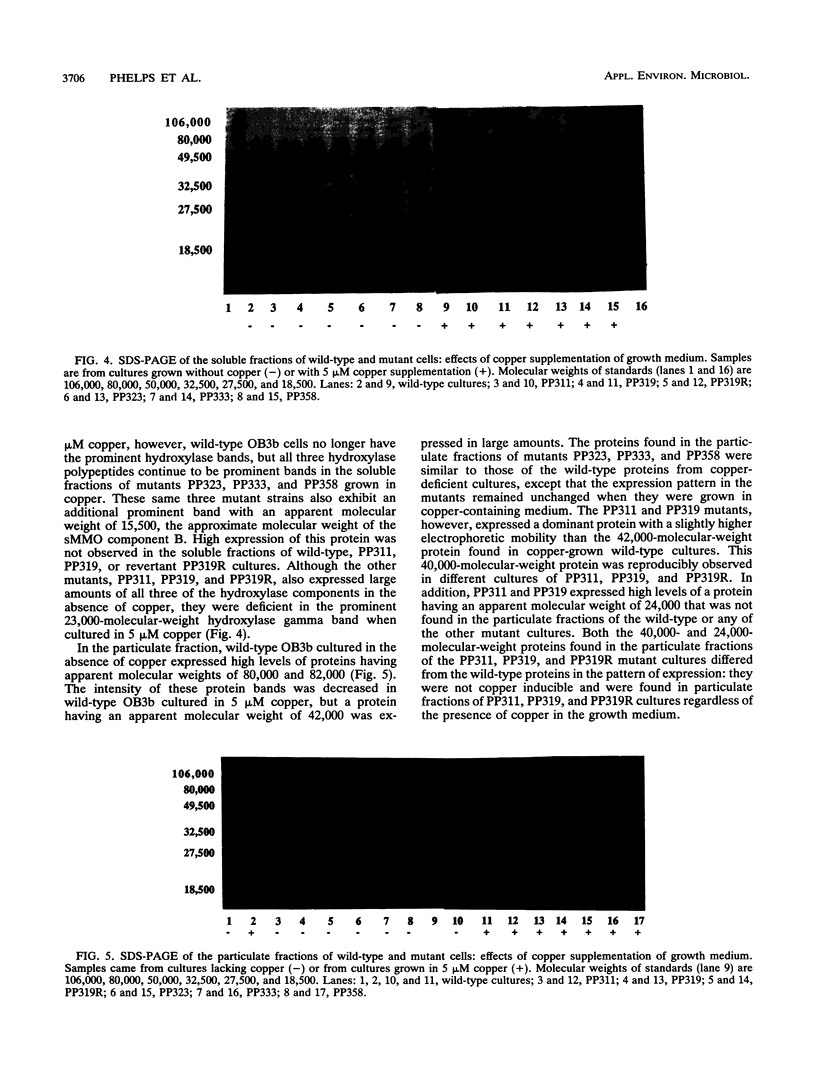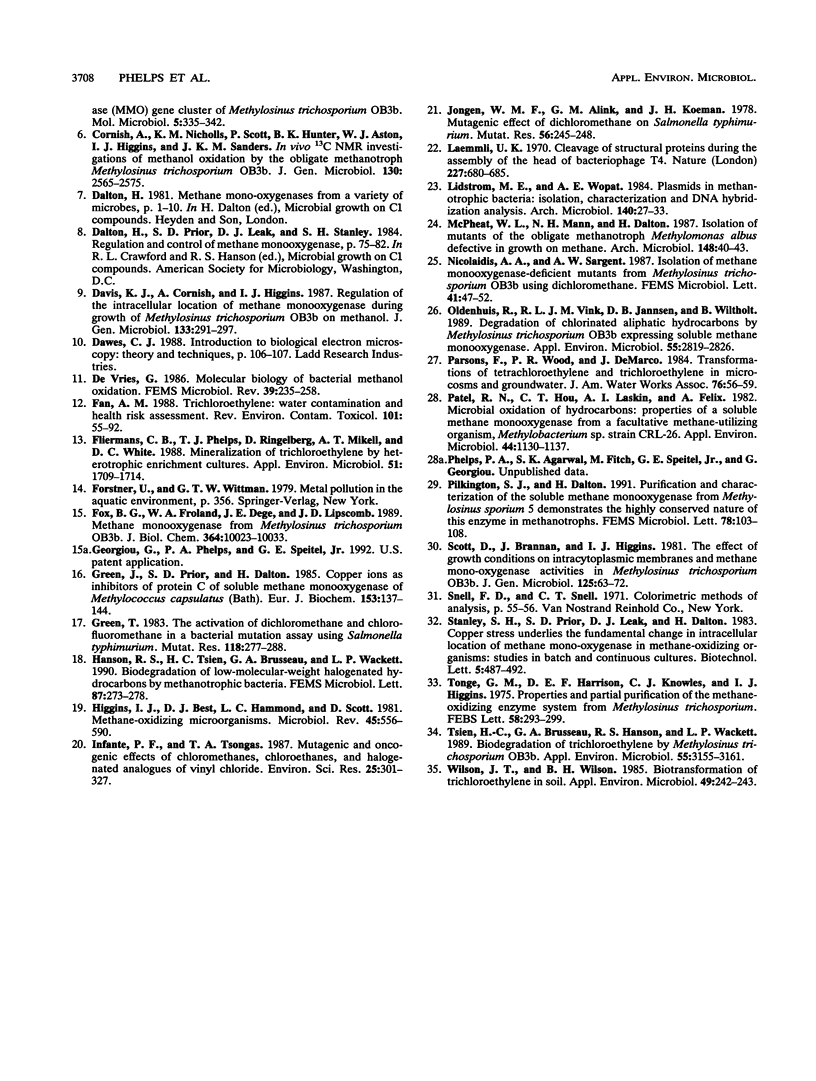Abstract
The methanotrophic bacterium Methylosinus trichosporium OB3b is unusually active in degrading recalcitrant haloalkanes such as trichloroethylene (TCE). The first and rate-limiting step in the degradation of TCE is catalyzed by a soluble methane monooxygenase (sMMO). This enzyme is not expressed when the cells are grown in the presence of copper at concentrations typically found in polluted groundwater. Under these conditions, M. trichosporium OB3b expresses a particulate form of the enzyme (pMMO), which has a narrow substrate specificity and does not degrade TCE at any significant rate. We have isolated M. trichosporium OB3b mutants that are deficient in pMMO and express sMMO constitutively in the presence of elevated concentrations of copper. One mutant (PP358) exhibited a TCE degradation rate which was almost twice as high as that of the wild-type strain grown under optimal conditions (without copper). All of the mutants lost the ability to express pMMO activity and to form stacked intracellular membranes characteristic of wild-type cells expressing pMMO.
Full text
PDF







Images in this article
Selected References
These references are in PubMed. This may not be the complete list of references from this article.
- Bradford M. M. A rapid and sensitive method for the quantitation of microgram quantities of protein utilizing the principle of protein-dye binding. Anal Biochem. 1976 May 7;72:248–254. doi: 10.1016/0003-2697(76)90527-3. [DOI] [PubMed] [Google Scholar]
- Brusseau G. A., Tsien H. C., Hanson R. S., Wackett L. P. Optimization of trichloroethylene oxidation by methanotrophs and the use of a colorimetric assay to detect soluble methane monooxygenase activity. Biodegradation. 1990;1(1):19–29. doi: 10.1007/BF00117048. [DOI] [PubMed] [Google Scholar]
- Fan A. M. Trichloroethylene: water contamination and health risk assessment. Rev Environ Contam Toxicol. 1988;101:55–92. doi: 10.1007/978-1-4612-3770-9_2. [DOI] [PubMed] [Google Scholar]
- Fliermans C. B., Phelps T. J., Ringelberg D., Mikell A. T., White D. C. Mineralization of trichloroethylene by heterotrophic enrichment cultures. Appl Environ Microbiol. 1988 Jul;54(7):1709–1714. doi: 10.2172/666263. [DOI] [PMC free article] [PubMed] [Google Scholar]
- Fox B. G., Froland W. A., Dege J. E., Lipscomb J. D. Methane monooxygenase from Methylosinus trichosporium OB3b. Purification and properties of a three-component system with high specific activity from a type II methanotroph. J Biol Chem. 1989 Jun 15;264(17):10023–10033. [PubMed] [Google Scholar]
- Green J., Prior S. D., Dalton H. Copper ions as inhibitors of protein C of soluble methane monooxygenase of Methylococcus capsulatus (Bath). Eur J Biochem. 1985 Nov 15;153(1):137–144. doi: 10.1111/j.1432-1033.1985.tb09279.x. [DOI] [PubMed] [Google Scholar]
- Green T. The metabolic activation of dichloromethane and chlorofluoromethane in a bacterial mutation assay using Salmonella typhimurium. Mutat Res. 1983 Sep;118(4):277–288. doi: 10.1016/0165-1218(83)90211-2. [DOI] [PubMed] [Google Scholar]
- Hanson R. S., Tsien H. C., Tsuji K., Brusseau G. A., Wackett L. P. Biodegradation of low-molecular-weight halogenated hydrocarbons by methanotrophic bacteria. FEMS Microbiol Rev. 1990 Dec;7(3-4):273–278. doi: 10.1111/j.1574-6968.1990.tb04924.x. [DOI] [PubMed] [Google Scholar]
- Higgins I. J., Best D. J., Hammond R. C., Scott D. Methane-oxidizing microorganisms. Microbiol Rev. 1981 Dec;45(4):556–590. doi: 10.1128/mr.45.4.556-590.1981. [DOI] [PMC free article] [PubMed] [Google Scholar]
- Jongen W. M., Alink G. M., Koeman J. H. Mutagenic effect of dichloromethane on Salmonella typhimurium. Mutat Res. 1978 Jan;56(3):245–248. doi: 10.1016/0027-5107(78)90191-4. [DOI] [PubMed] [Google Scholar]
- Laemmli U. K. Cleavage of structural proteins during the assembly of the head of bacteriophage T4. Nature. 1970 Aug 15;227(5259):680–685. doi: 10.1038/227680a0. [DOI] [PubMed] [Google Scholar]
- Lidstrom M. E., Wopat A. E. Plasmids in methanotrophic bacteria: isolation, characterization and DNA hybridization analysis. Arch Microbiol. 1984 Nov;140(1):27–33. doi: 10.1007/BF00409767. [DOI] [PubMed] [Google Scholar]
- Oldenhuis R., Vink R. L., Janssen D. B., Witholt B. Degradation of chlorinated aliphatic hydrocarbons by Methylosinus trichosporium OB3b expressing soluble methane monooxygenase. Appl Environ Microbiol. 1989 Nov;55(11):2819–2826. doi: 10.1128/aem.55.11.2819-2826.1989. [DOI] [PMC free article] [PubMed] [Google Scholar]
- Patel R. N., Hou C. T., Laskin A. I., Felix A. Microbial Oxidation of Hydrocarbons: Properties of a Soluble Methane Monooxygenase from a Facultative Methane-Utilizing Organism, Methylobacterium sp. Strain CRL-26. Appl Environ Microbiol. 1982 Nov;44(5):1130–1137. doi: 10.1128/aem.44.5.1130-1137.1982. [DOI] [PMC free article] [PubMed] [Google Scholar]
- Tonge G. M., Harrison D. E., Knowles C. J., Higgins I. J. Properties and partial purification of the methane-oxidising enzyme system from Methylosinus trichosporium. FEBS Lett. 1975 Oct 15;58(1):293–299. doi: 10.1016/0014-5793(75)80282-1. [DOI] [PubMed] [Google Scholar]
- Tsien H. C., Brusseau G. A., Hanson R. S., Waclett L. P. Biodegradation of trichloroethylene by Methylosinus trichosporium OB3b. Appl Environ Microbiol. 1989 Dec;55(12):3155–3161. doi: 10.1128/aem.55.12.3155-3161.1989. [DOI] [PMC free article] [PubMed] [Google Scholar]
- Wilson J. T., Wilson B. H. Biotransformation of trichloroethylene in soil. Appl Environ Microbiol. 1985 Jan;49(1):242–243. doi: 10.1128/aem.49.1.242-243.1985. [DOI] [PMC free article] [PubMed] [Google Scholar]





